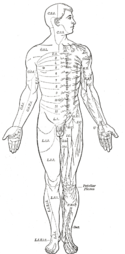Evolution of nervous systems
The evolution of nervous systems dates back to the first development of
Simple
Neural precursors
Sponges
Sponges have no cells connected to each other by synaptic junctions, that is, no neurons, and therefore no nervous system. They do, however, have homologs of many genes that play key roles in synaptic function. Recent studies have shown that sponge cells express a group of proteins that cluster together to form a structure resembling a postsynaptic density (the signal-receiving part of a synapse).[13] However, the function of this structure is currently unclear. Although sponge cells do not show synaptic transmission, they do communicate with each other via calcium waves and other impulses, which mediate some simple actions such as whole-body contraction.[14] Other ways sponge cells communicate with neighboring cells is through vesicular transport across highly dense regions of the cell membranes. These vesicles carry ions and other signaling molecules, but contain no true synaptic function.[15]
Nerve nets
The development of the nervous system in
Nerve cords

The vast majority of existing animals are bilaterians, meaning animals with left and right sides that are approximate mirror images of each other. All bilateria are thought to have descended from a common wormlike ancestor that appeared in the Cryogenian period, 700–650 million years ago.[18] The fundamental bilaterian body form is a tube with a hollow gut cavity running from mouth to anus, and a nerve cord with an especially large ganglion at the front, called the "brain".

Even
Bilaterians can be divided, based on events that occur very early in embryonic development, into two groups (
Annelida
Nematoda
The nervous system of one very small worm, the
Arthropods

In insects, many neurons have cell bodies that are positioned at the edge of the brain and are electrically passive—the cell bodies serve only to provide metabolic support and do not participate in signalling. A protoplasmic fiber runs from the cell body and branches profusely, with some parts transmitting signals and other parts receiving signals. Thus, most parts of the insect brain have passive cell bodies arranged around the periphery, while the neural signal processing takes place in a tangle of protoplasmic fibers called neuropil, in the interior.[26]
Evolution of central nervous systems
Evolution of the human brain
There has been a gradual increase in
Brain evolution can be studied using
See also
References
- ^ "nervous system | Definition, Function, Structure, & Facts". Encyclopædia Britannica. Retrieved 2021-04-07.
- ^ Arendt, D. (2021). Elementary Nervous Systems. Philosophical Transactions of the Royal Society B: Biological Sciences, 376 (1821), 20200347. https://doi.org/10.1098/rstb.2020.0347
- ^ Arendt, D., Benito-Gutierrez, E., Brunet, T., & Marlow, H. (2015). Gastric pouches and the mucociliary sole: Setting the stage for nervous system evolution. Philosophical Transactions of the Royal Society B: Biological Sciences, 370 (1684), 20150286. https://doi.org/10.1098/rstb.2015.0286
- ^ Jékely, G., Paps, J. & Nielsen, C. The phylogenetic position of ctenophores and the origin(s) of nervous systems. EvoDevo 6, 1 (2015). https://doi.org/10.1186/2041-9139-6-1
- ^ a b Moroz, L. L., Romanova, D. Y., & Kohn, A. B. (2021). Neural versus alternative integrative systems: Molecular insights into origins of neurotransmitters. Philosophical Transactions of the Royal Society B: Biological Sciences, 376 (1821), 20190762. https://doi.org/10.1098/rstb.2019.0762
- ^ Musser, J. M., Schippers, K. J., Nickel, M. et al. (2021). Profiling cellular diversity in sponges informs animal cell type and nervous system evolution. Science, 374 (6568), 717–723. https://doi.org/10.1126/science.abj2949
- ^ Hayakawa, E., Guzman, C., Horiguchi, O. et al. Mass spectrometry of short peptides reveals common features of metazoan peptidergic neurons. Nat Ecol Evol (2022). https://doi.org/10.1038/s41559-022-01835-7
- ISBN 978-0-632-04496-2.
- PMID 28863228.
- ISBN 978-0-7735-4571-7.
- PMID 35277960.
- ^ Callier V (2022-06-03). "Brain-Signal Proteins Evolved Before Animals Did". Quanta Magazine. Retrieved 2022-06-03.
- PMID 17551586.
- PMID 21669752.
- PMID 25696821.
- ISBN 978-0-03-025982-1.
- ISBN 978-0-12-618621-5.
- PMID 21680418.
- PMID 14756331.
- PMID 12070079.
- PMID 15770230.
- PMID 29236686.
- S2CID 30827888.
- ^ "Specification of the nervous system". Wormbook.
- ISBN 978-0-521-57890-5.
- ^ Chapman, p. 546
- ^ Ko KH (2016). "Origins of human intelligence: The chain of tool-making and brain evolution" (PDF). Anthropological Notebooks. 22 (1): 5–22.
- S2CID 26441.
- ISBN 978-90-272-9121-9.
- ISBN 978-0-12-804096-6.
